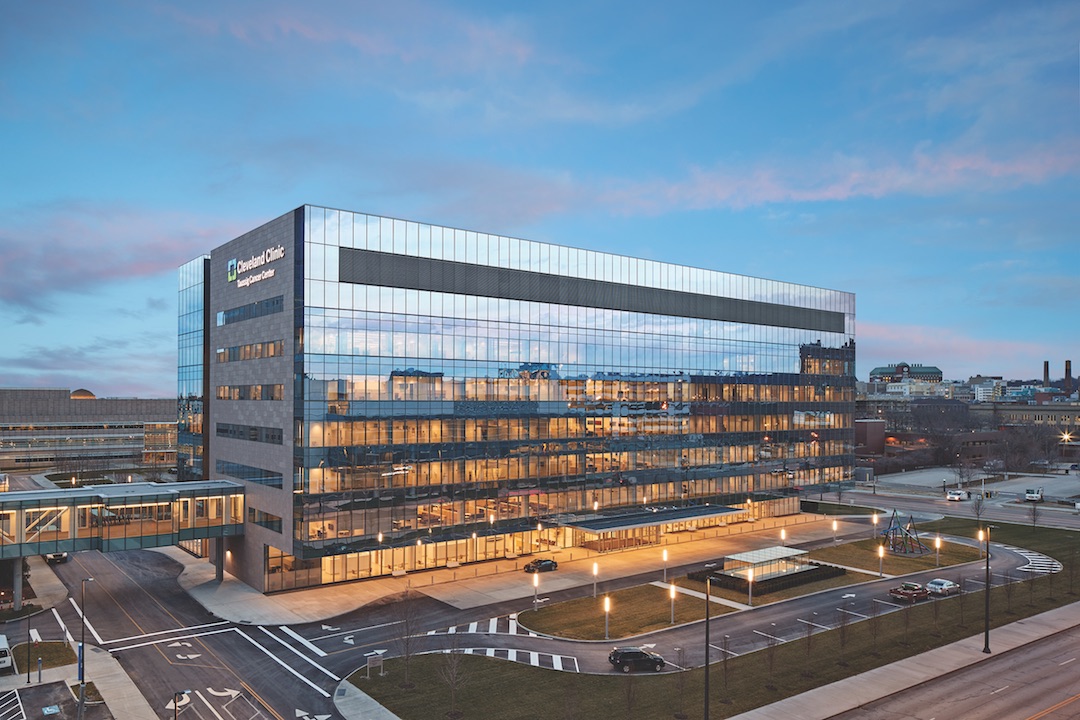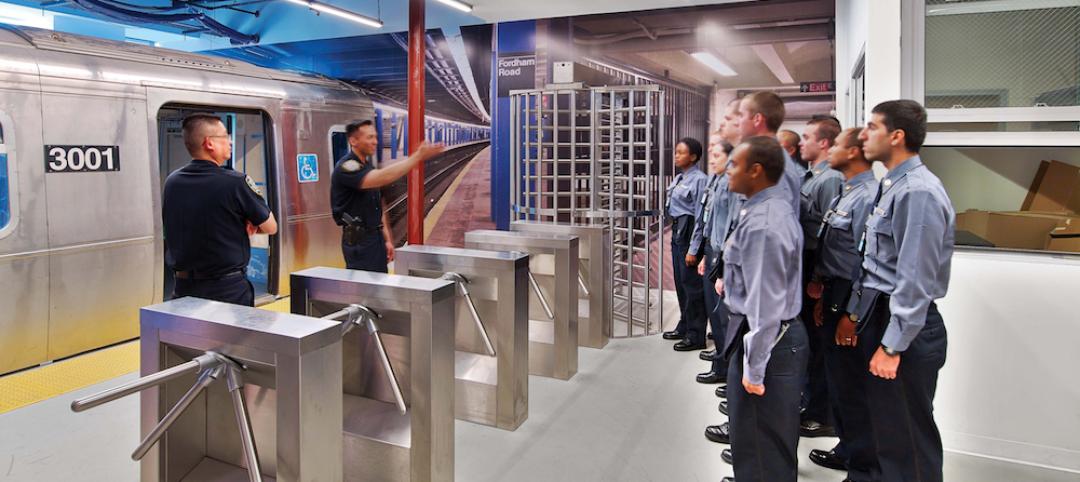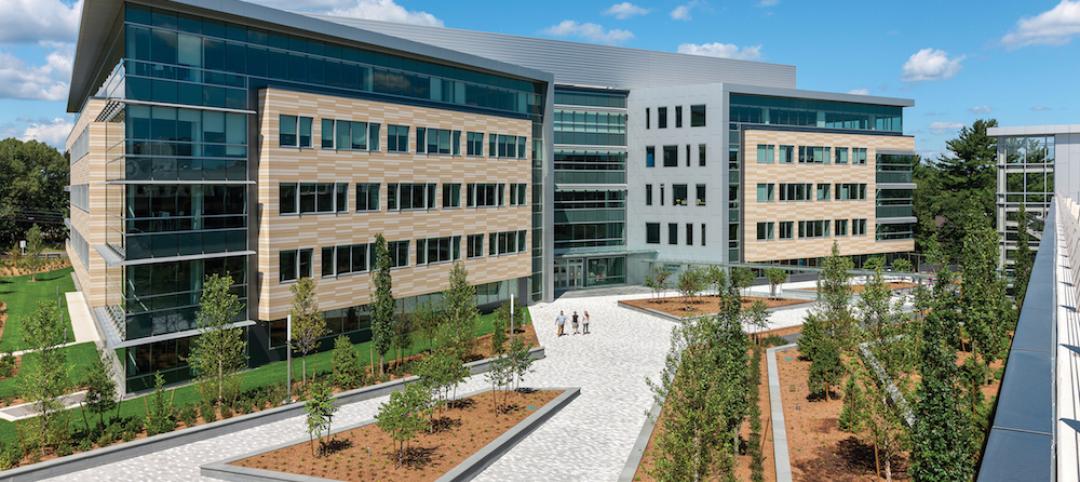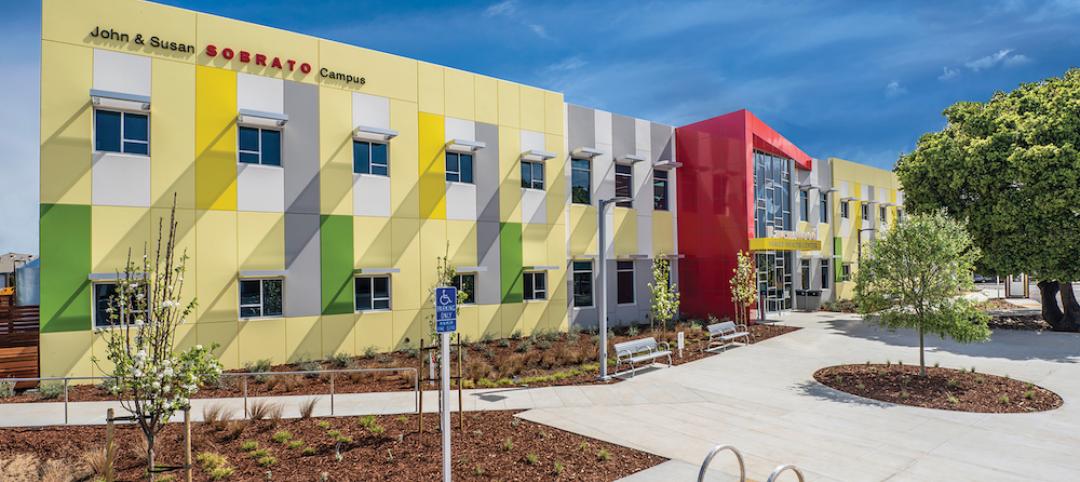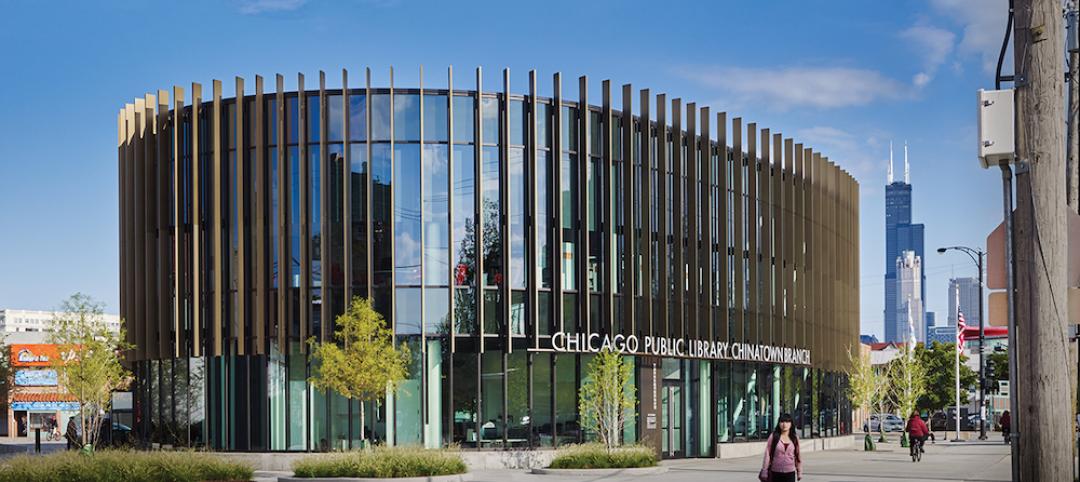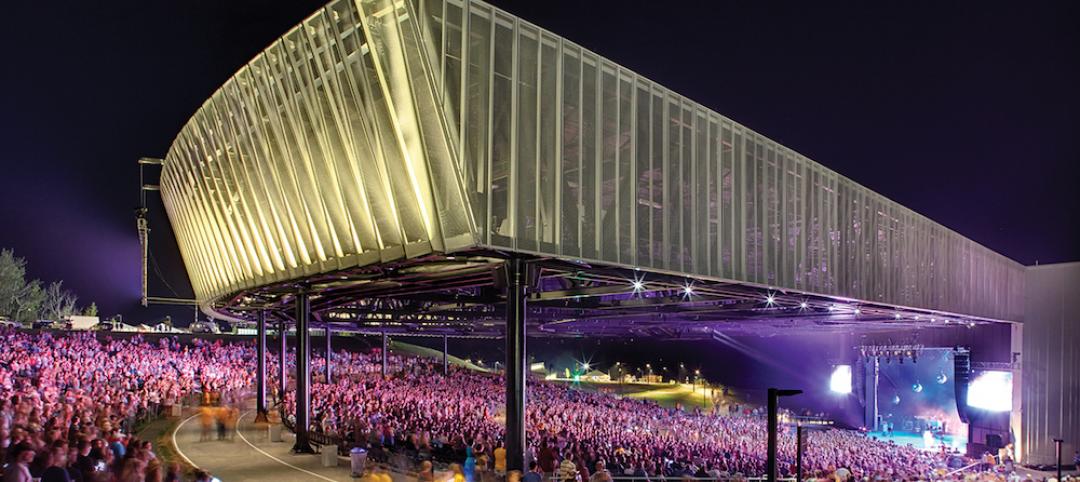The design of the Cleveland Clinic Taussig Cancer Center was developed with one main guiding principle: optimize patient treatment and provide multidisciplinary care for them under one roof. The new 390,220-sf facility condensed the cancer services into one efficient building while improving the overall treatment process for both the patients and their families.
The healthcare facility’s project team adopted the Cleveland Clinic’s Owner-Controlled Team Project Delivery Method (OCTPD) to complete the project on time and under budget. OCTPD is Cleveland Clinic’s practice model of project delivery where the owner provides the knowledge and leadership to lead a team of industry experts to define and deliver a project by maximizing the benefits of coordinated teamwork.
The resulting seven-story, patient-first facility includes 126 exam rooms, 98 infusion bays, diagnostic imaging and genetics/genomics testing, dedicated areas for clinical trials, and 176 physician offices with support and conference areas.
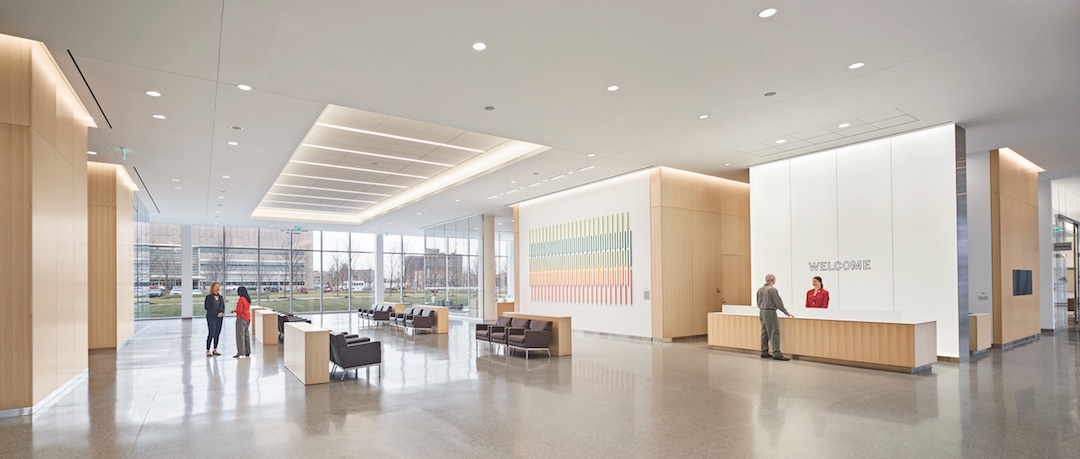 Robert Benson Photography.
Robert Benson Photography.
Natural light pierces the building from every angle, but the project team determined it was especially important for patient treatment areas to form a connection to nature. In the lower level radiation oncology treatment floor, high ceilings were used to bring in more light to the lower level and a large skylight structure allows daylight to pour in from above. Floors two through four are tabbed for infusion treatment with exam rooms and infusion bays that are all aligned along the north elevation to provide exterior views across the landscaped campus spine. Infusion patients may be in treatment for up to six hours, so providing this connection to nature with wide-open views was especially important.
The first floor focuses on support services that include a private cancer hematology lab, a wellness center with reflexology and massage therapies, art and music therapy, a retail pharmacy, a boutique where patients can get assistance with wigs, prosthetics, and makeup, a resource center, and a meditation space. Administrative offices are located on floors five and six and also include bountiful natural light.
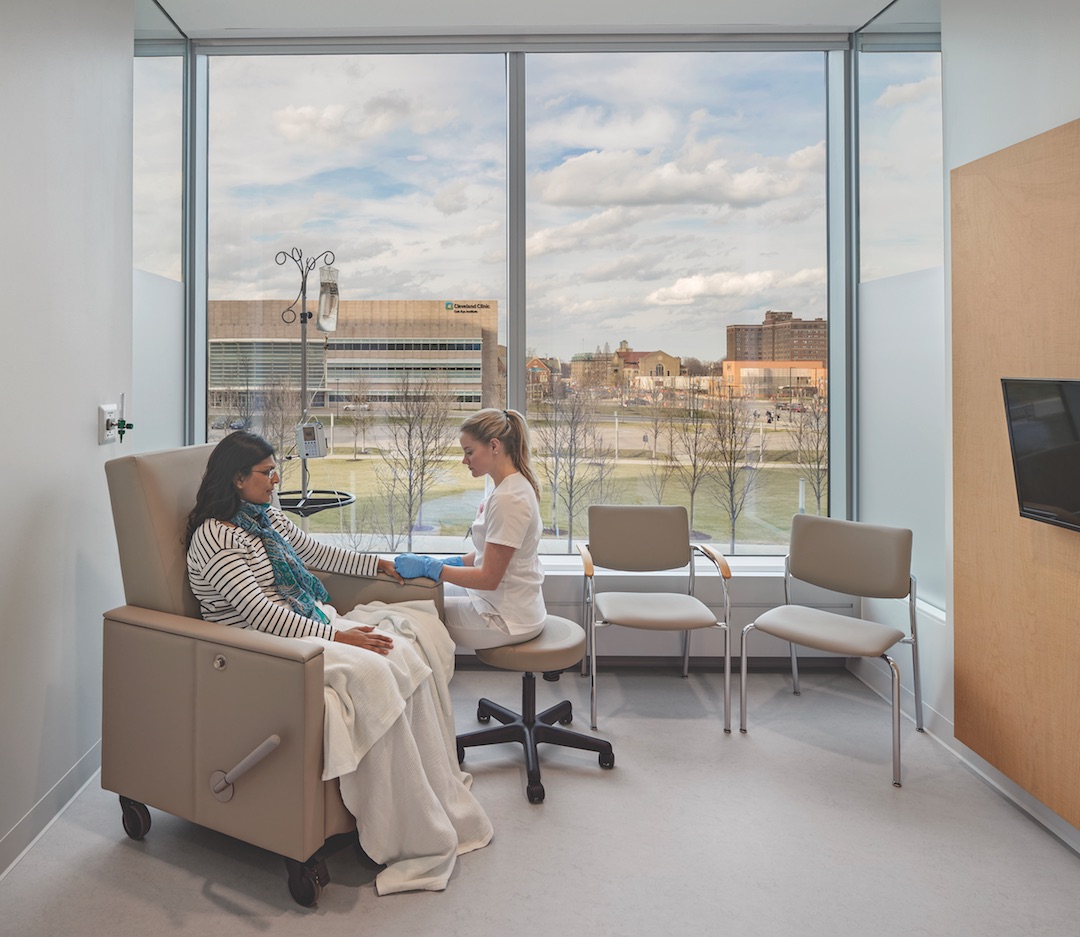 The infusion treatment exam rooms and infusion bays are aligned along the north elevation to provide exterior views across the landscaped campus spine. Robert Benson Photography.
The infusion treatment exam rooms and infusion bays are aligned along the north elevation to provide exterior views across the landscaped campus spine. Robert Benson Photography.
The steel-framed building uses composite floor slabs supported by a mat foundation. The building envelope consists of a unitized aluminum curtain wall with glass and granite panels. A 30-foot slab cantilevers out over the entire 350-foot span of the south façade and main entry.
Prefabrication methods were used to improve quality, enhance the schedule, and reduce the cost of the project. The MEP engineer set up a prefabrication warehouse a few miles from the project site where a significant portion of the above-ceiling MEP racks were built before being transferred to the site and installed.
BIM played a critical role in the project. A preliminary model was used during pre-construction to help inform the estimating effort as the design’s costs were being established. When design-assist contractors for mechanical, electrical, and fire protection were selected, they immediately began working with the design team to evaluate the early MEPFP models for cost and constructability. A common cloud-based server housed all the current models so any team member could see any other partner’s current model and perform “clash tests” between the models.
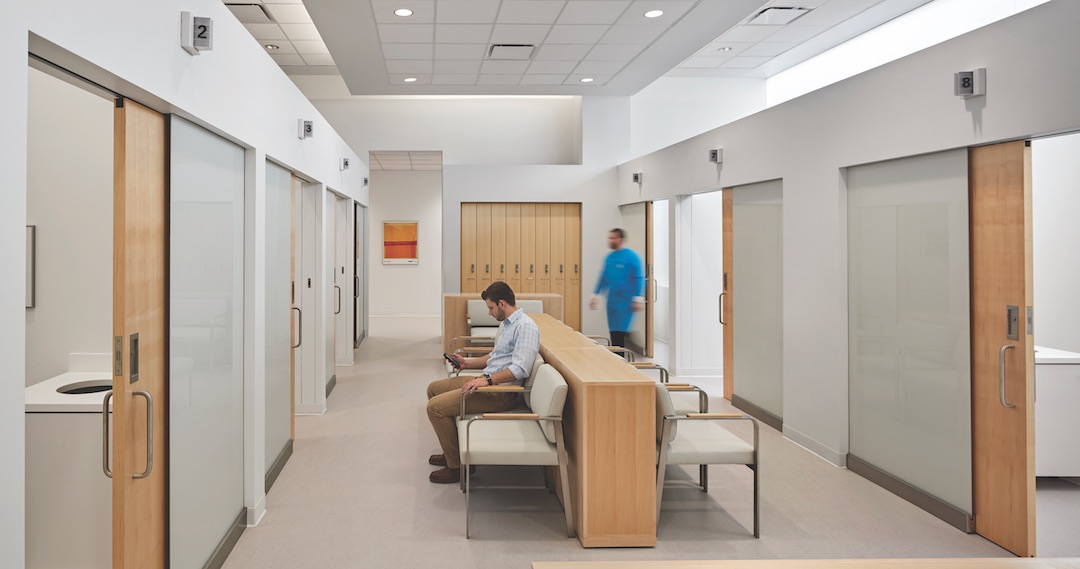 Changing room. Robert Benson Photography.
Changing room. Robert Benson Photography.
As each member of the team modeled their support system, they also modeled the hangers used to support them. This allowed the team to map the coordinates of the hangers and install them prior to the pouring of the concrete floors. Not only was the installation safer and faster, it also ensured 100% compliance with the approved model/design and eliminated any clashes in the field. Additionally, simple mockups created from tape and cardboard helped to ensure efficient room layout for users to provide the best care possible. These mockups helped save about $1.5 million from future user change requests.
Overall, the project team achieved substantial completion of the building on the same day identified 27 months earlier at ground breaking. The final construction cost resulted in an overall savings to the owner of $21 million, $17 million of which was directly attributed to the collaborative efforts of the design and construction team.
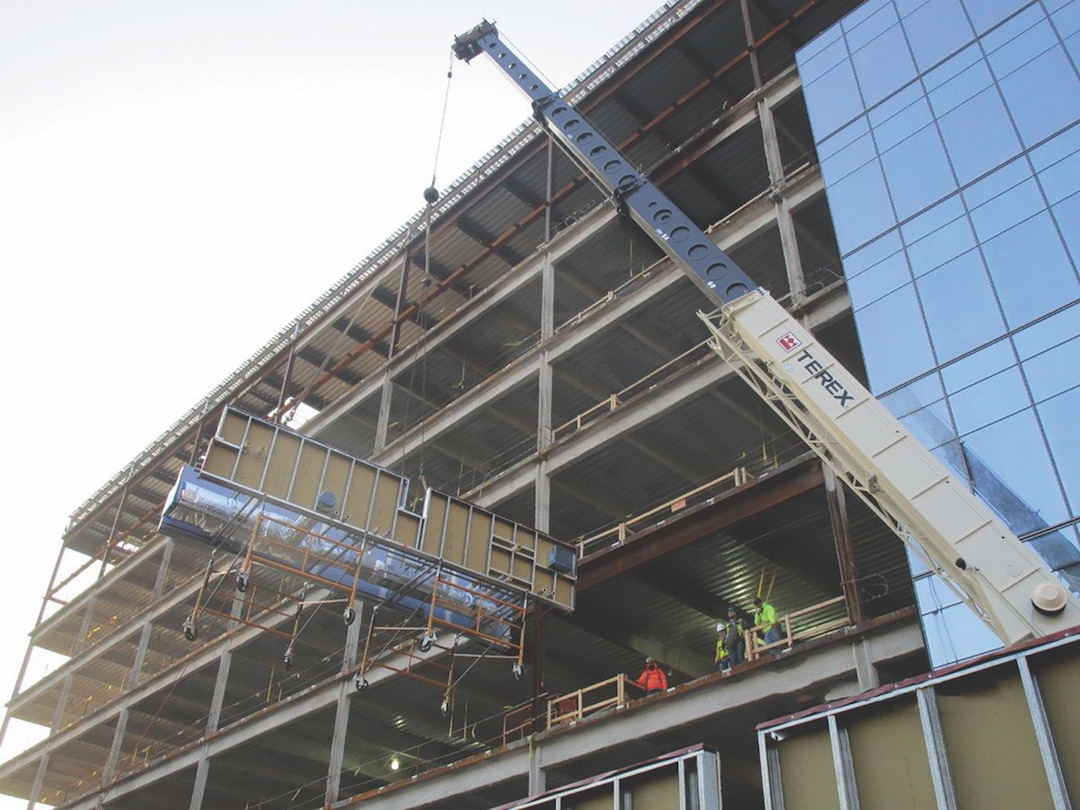 The team employed prefabrication techniques, including MEP trade racks, to improve quality, enhance the schedule, and reduce costs.
The team employed prefabrication techniques, including MEP trade racks, to improve quality, enhance the schedule, and reduce costs.
Building Team — Submitting firm, general contractor Turner Construction Company Owner Cleveland Clinic Architect William Rawn Associates Architect of record Stantec Structural engineer LeMessurier Consultants MEP engineer Bard, Rao + Athanas Consulting Engineers
General Information — Size 380,000 sf Construction cost $190 million Construction time September 2014 to June 2017 Delivery method CM at risk
Return to the 2018 Building Team Awards Landing Page
Related Stories
Building Team Awards | May 27, 2016
Big police academy trains thousands of New York's finest
The Police Training Academy in Queens, N.Y., consists of a 480,000-sf academic/administration building and a 240,000-sf physical training facility, linked by an aerial pedestrian bridge.
Building Team Awards | May 26, 2016
Cimpress office complex built during historically brutal Massachusetts winter
Lean construction techniques were used to build 275 Wyman Street during a winter that brought more than 100 inches of snow to suburban Boston.
Building Team Awards | May 25, 2016
New health center campus provides affordable care for thousands of Northern Californians
The 38,000-sf, two-level John & Susan Sobrato Campus in Palo Alto is expected to serve 25,000 patients a year by the end of the decade.
Building Team Awards | May 24, 2016
Los Angeles bus depot squeezes the most from a tight site
The Building Team for the MTA Division 13 Bus Operations and Maintenance Facility fit 12 acres’ worth of programming in a multi-level structure on a 4.8-acre site.
Building Team Awards | May 23, 2016
'Greenest ballpark' proves a winner for St. Paul Saints
Solar arrays, a public art courtyard, and a picnic-friendly “park within a park" make the 7,210-seat CHS Field the first ballpark to meet Minnesota sustainable building standards.
Building Team Awards | May 20, 2016
Pittsburgh's Tower at PNC Plaza raises the bar on high-rise greenness
The Building Team designed the 800,000-sf tower to use 50% less energy than a comparable building. A 1,200-sf mockup allowed the team to test for efficiency, functionality, and potential impact on the building’s occupants.
Building Team Awards | May 19, 2016
Chinatown library unites and serves two emerging Chicago neighborhoods
The 16,000-sf, pebble-shaped Chinatown Branch Library was built at the intersection of new and old Chinatown neighborhoods. The goal is for the building to unite the communities and serve as a catalyst for the developing area.
Building Team Awards | May 19, 2016
NYC subway station lights the way for 300,000 riders a day
Fulton Center, which handles 85% of the riders coming to Lower Manhattan, is like no other station in the city’s vast underground transit web—and that’s a good thing.
Building Team Awards | May 16, 2016
Upstate New York performing arts center revives once-toxic lakefront site
Early coordination, prefabrication, and judicious value engineering contributed to the accelerated completion of the Onondaga Lakeview Ampitheater, a Upstate New York design-build project.
Building Team Awards | May 16, 2016
12 building projects that represent the best in AEC team collaboration
A busy, light-filled Manhattan subway station and a pebble-shaped Chicago library are among the winners of the 19th annual Building Team Awards.


